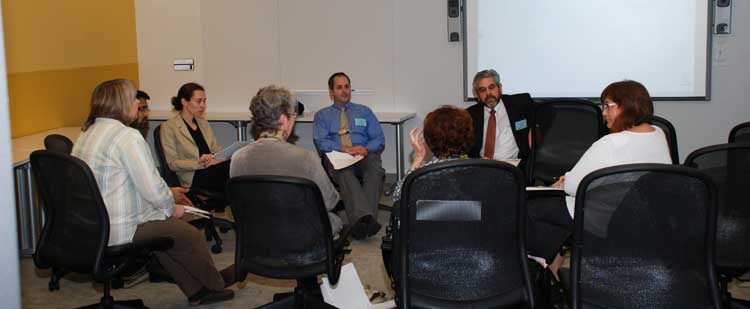
Comments? Contact IEE.
1. Objectives
2. Outline a structure and name four steps in planning small group learning sessions.
3. List five essential tasks of a small group facilitator.
4. Name three common facilitation challenges in small group learning and describe one strategy to address each of them.
2. Preparation in Advance
3. The Module
- 1. Overview & Rationale
- 2. Planning
- 3. Facilitation Strategies
- 4. Meet the Professor: Janet Serwint
- 5. Meet the Professor: Randy Barker
- 6. Meet the Professor: Danelle Cayea
This module will introduce you to small group learning as a teaching method and includes a discussion of the rationale for small group learning, planning and facilitating for effective small group learning as well as a review of common facilitation challenges in small group learning and strategies to address them.
By the end of this module you should recognize the benefits of small group learning and have increased confidence in your ability to plan and facilitate small group learning activities.
To begin, let’s consider the question, “What is small group learning and how does it differ from other teaching formats?”
Small group learning is used in multiple contexts in medical and biomedical education. Small groups may serve as companion or supplemental groups to traditional lecture formats, help learning in the lab, represent clinical teaching units such as the “ward team”, or represent the main learning unit of a course or curriculum.
Small group size may vary depending in the context of learning and consideration of the optimal size and composition is important. However, the exact size of a small group is much less critical than what happens in a small group in terms of teaching and learning.
Small group learning is characterized by learning that is active, collaborative, and self-directed. Small group learning emphasizes a supportive and open learning environment. In effective small group learning experiences, students may discuss ideas, compare and contrast opinions, test hypotheses, practice skills, receive real time feedback and reflect on their learning needs and goals. Contrast this experience with, for example, the traditional medical or biomedical lecture in which learning is more passive, unidirectional, and instructor-directed. (Although we hope that you have discovered techniques to make lectures more active for learners in the module on lectures.)
Small group learning often requires more resources (facilitators, space, time) and effort to plan and execute. So why bother?
Thoughtfully planned and skillfully executed small group learning has the potential to create rich and meaningful learning experiences. Effective small group learning allows for the application of theoretical learning into real world contexts and contributes to mastery of higher order skills, which ultimately results in deeper and longer lasting learning. There are many opportunities for small group learning (both formal and informal) in medical and biomedical education. Improving your understanding of small group learning will allow you to make the most of these opportunities for your learners and yourself.
Hopefully this will convince you that the effort to plan and execute small group learning activities is well worth it for learners and teachers.
The key features of small group learning include:
Active learning
Collaborative learning
Self-directed learning
Supportive and open learning environment
(See module on Adult Learning Principles for a description of these)
As you read through this module, continue to reflect on your own experiences teaching or learning in small groups. What do you notice about these experiences that promote learning that is active, collaborative, and that encourages learners to take initiative for their own learning? How would you describe the learning environment?
4. Application of the Module
During an upcoming small group learning session, if possible, observe the group carefully to identify different participation and learning styles. Consider facilitation strategies and educational activities that might address a range of participation and engage a variety of learning styles.
5. Next Steps and Peer Coaching
Think about your experiences leading and planning small group sessions. What will you do differently when planning and facilitating small group sessions after viewing this module?
6. Summary Points
1. Small group learning allows for the application of theoretical learning to real world experience.
2. The hallmarks of small group learning include: active, collaborative, and self-directed learning that occurs in a supportive environment.
3. Teaching in small group settings involves the facilitation of learning as opposed to simply the transmission of knowledge.
About the Author

Associate Professor of Medicine
Co-Director Faculty Development Program in Teaching Skills
Johns Hopkins Bayview Medical Center
Johns Hopkins University School of Medicine
Module Editor
Joseph Cofrancesco Jr., MD, MPH, FACP
Director of the Institute for Excellence in Education
Johns Hopkins University School of Medicine Institute for Excellence in Education Professor of Medicine
Johns Hopkins University School of Medicine
